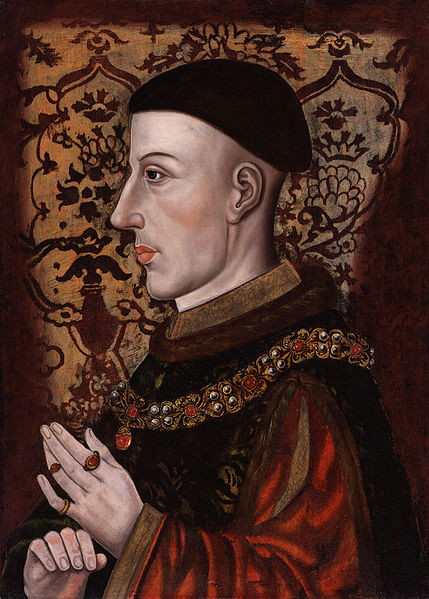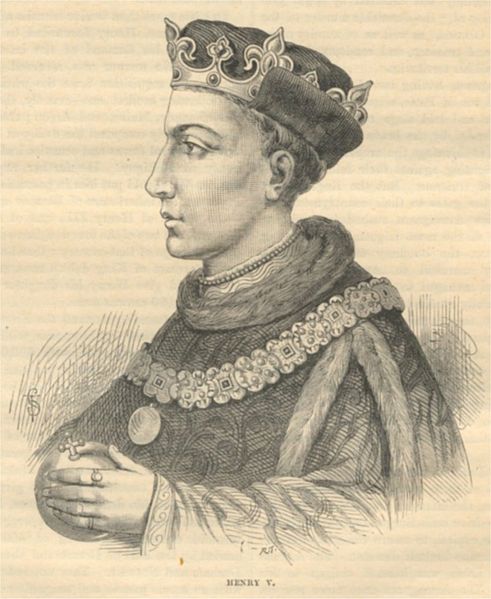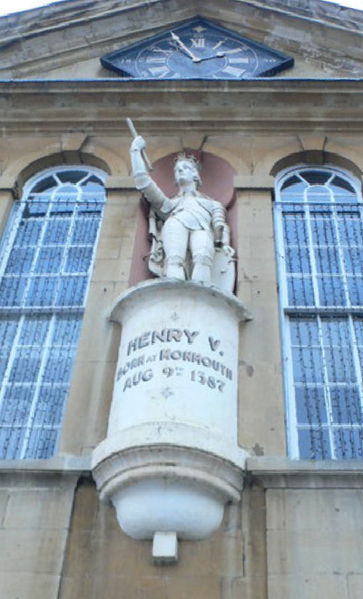<Back to Index>
- King of England Henry V, 1386
PAGE SPONSOR



Henry V (16 September 1386 – 31 August 1422) was King of England from 1413 until his death at the age of 35 in 1422. He was the second English monarch who was a member of the House of Lancaster.
After military experience fighting various lords who rebelled against his father, Henry IV, Henry came into political conflict with the increasingly ill king. After his father's death, Henry rapidly assumed control of the country and embarked on war with France. From an unassuming start, his military successes in the Hundred Years' War, culminating with his famous victory at the Battle of Agincourt, saw him come close to conquering France. After months of negotiation with Charles VI of France, the Treaty of Troyes recognized Henry V as regent and heir - apparent to the French throne, and he was subsequently married to Charles' daughter, Catherine of Valois. Following Henry V's sudden death in France of dysentery, he was succeeded by his infant son, who reigned as Henry VI.
Henry features in three plays by William Shakespeare. He is shown as a young scapegrace who redeems himself in battle in the two Henry IV plays and as a decisive leader in Henry V.
Henry was born in the tower above the gatehouse of Monmouth Castle and for that reason called Henry of Monmouth, son of Henry of Bolingbroke, later Henry IV, and sixteen year old Mary de Bohun. Two dates are suggested: 9 August or 16 September, in either 1386 or 1387. At the time of his birth during the reign of Richard II, Henry was not in line to succeed to the throne, preceded by the king and possibly another collateral line of heirs.
Upon the exile of Henry's father in 1398, Richard II took the boy into his own charge and treated him kindly. The young Henry accompanied King Richard to Ireland, and while in the royal service, he visited the castle at Trim in Meath, the ancient meeting place of the Irish Parliament. In 1399, the Lancastrian usurpation brought Henry's father to the throne and Henry was recalled from Ireland into prominence as heir to the kingdom of England. He was created Prince of Wales at his father's coronation. He was created Duke of Lancaster on 10 November 1399, the third person to hold the title that year. His other titles were Duke of Cornwall, Earl of Chester, and Duke of Aquitaine. A contemporary record notes that during that year Henry spent time at The Queen's College, Oxford, under the care of his uncle Henry Beaufort, the Chancellor of the university. From 1400 to 1404 he carried out the duties of High Sheriff of Cornwall
From October 1401, the administration was conducted in his name. Less than three years later, Henry was in command of part of the English forces — he led his own army into Wales against Owain Glyndŵr and joined forces with his father to fight Harry Hotspur at Shrewsbury in 1403.
It was there that the sixteen year old prince was almost killed by an
arrow which became stuck in his face. An ordinary soldier might have
died from such a wound, but Henry had the benefit of the best possible
care. Over a period of several days John Bradmore, the royal physician, treated the wound with honey to act as an antiseptic,
crafted a special tool to screw into the broken arrow shaft and thus
extract the arrow without doing further damage, and then flushed the
wound with alcohol.
The operation was successful, but it left Henry with permanent scars
which would serve as evidence of his experience in battle.
For eighteen months, in 1410 – 1411, Henry was in control of the country
during his father's ill health and he took full opportunity to impose
his own policies, but when the king recovered he reversed most of these
and dismissed the prince from his council.
The Welsh revolt of Owain Glyndŵr absorbed Henry's energies until 1408. Then, as a result of the king's ill health, Henry began to take a wider share in politics. From January 1410, helped by his uncles Henry and Thomas Beaufort — legitimated sons of John of Gaunt — he had practical control of the government.
Both in foreign and domestic policy he differed from the king, who in
November 1411 discharged the prince from the council. The quarrel of
father and son was political only, though it is probable that the
Beauforts had discussed the abdication of Henry IV, and their opponents
certainly endeavored to defame the prince.
It may be to that political enmity that the tradition of Henry's riotous youth, immortalized by Shakespeare, is partly due. Henry's record of involvement in war and politics, even in his youth, disproves this tradition. The most famous incident, his quarrel with the chief justice, has no contemporary authority and was first related by Sir Thomas Elyot in 1531.
The story of Falstaff originated in Henry's early friendship with Sir
John Oldcastle, a supporter of the Lollards. Shakespeare's Falstaff was
originally named "Oldcastle", following his main source, The Famous Victories of Henry V.
However, his descendants objected and the name was changed. That
friendship, and the prince's political opposition to Thomas Arundel,
Archbishop of Canterbury, perhaps encouraged Lollard hopes. If so, their
disappointment may account for the statements of ecclesiastical
writers, like Thomas Walsingham, that Henry on becoming king was changed
suddenly into a new man.
After Henry IV died on 20 March 1413, Henry V succeeded him and
was crowned on 9 April 1413 at Westminster Abbey.
The ceremony was marked by a terrible snow storm, but the common people
were undecided as to whether it was a good or bad omen.
Henry was described as having been "very tall (6ft 3 in), slim, with
dark hair cropped in a ring above the ears, and clean-shaven". His
complexion was ruddy, the face lean with a prominent and pointed nose.
Depending on his mood, his eyes "flashed from the mildness of a dove's
to the brilliance of a lion's".
Henry tackled all of the domestic policies together, and gradually built
on them a wider policy. From the first, he made it clear that he would
rule England as the head of a united nation. On the one hand he let past
differences be forgotten - the late Richard II was honorably reinterred; the young Mortimer
was taken into favor; the heirs of those who had suffered in the last
reign were restored gradually to their titles and estates. On the other
hand, where Henry saw a grave domestic danger, he acted firmly and
ruthlessly - such as the Lollard discontent in January 1414, including the execution by burning of Henry's old friend Sir John Oldcastle, so as to "nip the movement in the bud" and make his own position as ruler secure.
His reign was generally free from serious trouble at home. The exception was the Southampton Plot in favor of Mortimer, involving Henry Scrope, 3rd Baron Scrope of Masham and Richard, Earl of Cambridge (grandfather of the future King Edward IV) in July 1415.
Starting in August 1417, Henry V promoted the use of the English language in government, and his reign marks the appearance of Chancery Standard
English as well as the adoption of English as the language of record
within Government. He was the first king to use English in his personal
correspondence since the Norman conquest, which occurred 350 years earlier.
Henry could now turn his attention to foreign affairs. A writer of the next generation was the first to allege that Henry was encouraged by ecclesiastical statesmen to enter into the French war as a means of diverting attention from home troubles. This story seems to have no foundation. Old commercial disputes and the support which the French had lent to Owain Glyndŵr were used as an excuse for war, whilst the disordered state of France afforded no security for peace. The French king, Charles VI, was prone to mental illness, and his eldest son was an unpromising prospect.
Following Agincourt, Hungarian King (later Holy Roman Emperor 1433 – 1437) Sigismund made a visit to Henry in hopes of making peace between England and France. His goal was to persuade Henry to modify his demands against the French. Henry lavishly entertained the emperor and even had him enrolled in the Order of the Garter. Sigismund in turn inducted Henry into the Order of the Dragon. Henry had intended to crusade for the order after uniting the English and French thrones, but he died before fulfilling his plans. Sigismund left England several months later, having signed the Treaty of Canterbury, acknowledging English claims to France.
Henry may have regarded the assertion of his own claims as part of his
royal duty, but in any case, a permanent settlement of the national debate was essential to the success of his foreign policy.
On 11 August 1415 Henry sailed for France, where his forces besieged the fortress at Harfleur, capturing it on 22 September. Afterwards, Henry decided to march with his army across the French countryside towards Calais, despite the warnings of his council. On 25 October 1415, on the plains near the village of Agincourt, a French army intercepted his route. Despite his men - at - arms being exhausted, outnumbered and malnourished, Henry led his men into battle, decisively defeating the French who suffered severe losses. It is often argued that the French men - at - arms were bogged down in the muddy battlefield, soaked from the previous night of heavy rain, and that this hindered the French advance, allowing them to be sitting targets for the flanking English and Welsh archers. Most were simply hacked to death while completely stuck in the deep mud. Nevertheless, the victory is seen as Henry's greatest, ranking alongside Crécy and Poitiers.
During the battle, Henry made a decision that tarnished his reputation. He ordered that the French prisoners taken during the battle be put to death, including some of the most illustrious who could be used for ransom. Cambridge Historian Brett Tingley posits that Henry was concerned that the prisoners might turn on their captors when the English were busy repelling a third wave of enemy troops, thus jeopardizing a hard fought victory.
The victorious conclusion of Agincourt, from the English viewpoint, was only the first step in the campaign to recover the French possessions that belonged to the English crown.
Command of the sea was secured by driving the Genoese allies of the French out of the English Channel.
While Henry was occupied with peace negotiations in 1416, a French and
Genoese fleet surrounded the harbor at the English garrisoned Harfleur.
A French land force also besieged the town. To relieve Harfleur, Henry
sent his brother, John of Lancaster, the Duke of Bedford,
who raised a fleet and set sail from Beachy Head on 14 August. The
Franco - Genoese fleet was defeated the following day after a gruelling
seven hour battle, and Harfleur was relieved. Diplomacy successfully
detached Emperor Sigismund from France, and the Treaty of Canterbury (1416) paved the way to end the schism in the Church.
So, with those two potential enemies gone, and after two years of patient preparation following the battle of Agincourt, Henry renewed the war on a larger scale in 1417. Lower Normandy was quickly conquered, and Rouen cut off from Paris and besieged. This siege cast an even darker shadow on the reputation of the king than his order to slay the French prisoners at Agincourt. Rouen, starving and unable to support the women and children of the town forced them out through the gates believing that Henry would allow them to pass through his army unmolested. However, Henry refused to allow this and the expelled women and children died of starvation in the ditches surrounding the town. The French were paralyzed by the disputes between Burgundians and Armagnacs. Henry skilfully played them off one against the other, without relaxing his warlike approach.
In January 1419, Rouen fell. Those Norman French who had resisted were severely punished: Alan Blanchard, who had hanged English prisoners from the walls of Rouen, was summarily executed; Robert de Livet, Canon of Rouen, who had excommunicated the English king, was packed off to England and imprisoned for five years.
By August, the English were outside the walls of Paris. The intrigues of the French parties culminated in the assassination of John the Fearless by the Dauphin's partisans at Montereau (10 September 1419). Philip the Good, the new Duke, and the French court threw themselves into Henry's arms. After six months of negotiation, the Treaty of Troyes recognized Henry as the heir and regent of France, and on 2 June 1420, he married Catherine of Valois,
the French king's daughter. From June to July, Henry's army besieged
and took the castle at Montereau. He besieged and captured Melun in November, returning to England shortly thereafter.
On 10 June 1421, Henry sailed back to France for what would be his last military campaign. From July to August, Henry's forces besieged and captured Dreux, thus relieving allied forces at Chartres. That October, his forces lay siege to Meaux, capturing it on 2 May 1422.
Henry V died suddenly on 31 August 1422 at the Château de Vincennes near Paris, apparently from dysentery which he had contracted during the siege of Meaux. He was almost 36 years old.
Before his death, Henry V named his brother John, Duke of Bedford, regent of France in the name of his son Henry VI, then only a few months old. Henry V did not live to be crowned King of France himself, as he might confidently have expected after the Treaty of Troyes, because ironically the sickly Charles VI, to whom he had been named heir, survived him by two months. Henry's comrade - in - arms and Lord Steward John Sutton, 1st Baron Dudley, brought the body of King Henry home to England and bore the royal standard at his funeral. Henry V was buried in Westminster Abbey on 7 November 1422.
As Prince of Wales, Henry's arms were those of the kingdom, differenced by a label argent of three points. Upon his accession, he inherited use of the arms of the kingdom undifferenced.
He married Catherine of Valois in 1420, and their only child was Henry, who became Henry VI of England.